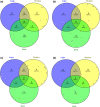Impact of roasting on the phenolic and volatile compounds in coffee beans
- PMID: 35844912
- PMCID: PMC9281936
- DOI: 10.1002/fsn3.2849
Impact of roasting on the phenolic and volatile compounds in coffee beans
Abstract
Phenolic compounds present in coffee beans could generate flavor and bring benefits to health. This study aimed to evaluate the impacts of commercial roasting levels (light, medium, and dark) on phenolic content and antioxidant potential of Arabica coffee beans (Coffea arabica) comprehensively via antioxidant assays. The phenolic compounds in roasted samples were characterized via liquid chromatography-electrospray ionization quadrupole time-of-flight mass spectrometry (LC-ESI-QTOF-MS/MS). Furthermore, the coffee volatile compounds were identified and semi-quantified by headspace/gas chromatography-mass spectrometry (HS-SPME-GC-MS). Generally, for phenolic and antioxidant potential estimation, light roasted samples exhibited the highest TPC (free: 23.97 ± 0.60 mg GAE/g; bound: 19.32 ± 1.29 mg GAE/g), DPPH, and FRAP. The medium roasted beans performed the second high in all assays but the highest ABTS+ radicals scavenging capacity (free: 102.37 ± 8.10 mg TE/g; bound: 69.51 ± 4.20 mg TE/g). Totally, 23 phenolic compounds were tentatively characterized through LC-ESI-QTOF-MS/MS, which is mainly adopted by 15 phenolic acid and 5 other polyphenols. The majority of phenolic compounds were detected in the medium roasted samples, followed by the light. Regarding GC-MS, a total of 20 volatile compounds were identified and semi-quantified which exhibited the highest in the dark followed by the medium. Overall, this study confirmed that phenolic compounds in coffee beans would be reduced with intensive roasting, whereas their antioxidant capacity could be maintained or improved. Commercial medium roasted coffee beans exhibit relatively better nutritional value and organoleptic properties. Our results could narrow down previous conflicts and be practical evidence for coffee manufacturing in food industries.
Keywords: Coffea arabica; GC‐MS; LC‐MS/MS; antioxidant properties; characterization; phenolic compounds; roasting; semi‐quantification; volatile compounds.
© 2022 The Authors. Food Science & Nutrition published by Wiley Periodicals LLC.
Conflict of interest statement
The authors declare no conflict of interest.
Figures
Similar articles
-
Effect of roasting degree on the antioxidant activity of different Arabica coffee quality classes.Acta Sci Pol Technol Aliment. 2016 Oct-Dec;15(4):409-417. doi: 10.17306/J.AFS.2016.4.39. Acta Sci Pol Technol Aliment. 2016. PMID: 28071018
-
Assessing polyphenols content and antioxidant activity in coffee beans according to origin and the degree of roasting.Rocz Panstw Zakl Hig. 2017;68(4):347-353. Rocz Panstw Zakl Hig. 2017. PMID: 29265388
-
Bioaccessibility and bioactivities of phenolic compounds from roasted coffee beans during in vitro digestion and colonic fermentation.Food Chem. 2022 Aug 30;386:132794. doi: 10.1016/j.foodchem.2022.132794. Epub 2022 Mar 24. Food Chem. 2022. PMID: 35349898
-
Variability of single bean coffee volatile compounds of Arabica and robusta roasted coffees analysed by SPME-GC-MS.Food Res Int. 2018 Jun;108:628-640. doi: 10.1016/j.foodres.2018.03.077. Epub 2018 Apr 3. Food Res Int. 2018. PMID: 29735099 Free PMC article.
-
Genotoxicity of Coffee, Coffee By-Products, and Coffee Bioactive Compounds: Contradictory Evidence from In Vitro Studies.Toxics. 2025 May 18;13(5):409. doi: 10.3390/toxics13050409. Toxics. 2025. PMID: 40423488 Free PMC article. Review.
Cited by
-
Identification, Bioaccessibility, and Antioxidant Properties of Phenolic Compounds in Carob Syrup.Foods. 2024 Jul 11;13(14):2196. doi: 10.3390/foods13142196. Foods. 2024. PMID: 39063280 Free PMC article.
-
Integrating Metabolomics and Proteomics Technologies Provides Insights into the Flavor Precursor Changes at Different Maturity Stages of Arabica Coffee Cherries.Foods. 2023 Mar 28;12(7):1432. doi: 10.3390/foods12071432. Foods. 2023. PMID: 37048253 Free PMC article.
-
Nutrient dynamics in the berry, bean, and husk of six Coffea canephora genotypes throughout fruit maturation.Sci Rep. 2025 Jul 29;15(1):27570. doi: 10.1038/s41598-025-13171-4. Sci Rep. 2025. PMID: 40730636 Free PMC article.
-
Water-Soluble Coffee Melanoidins Inhibit Digestive Proteases.J Agric Food Chem. 2024 Mar 20;72(11):5777-5783. doi: 10.1021/acs.jafc.3c09654. Epub 2024 Mar 8. J Agric Food Chem. 2024. PMID: 38456211 Free PMC article.
-
Quality Assessment of Ground Coffee Samples from Greek Market Using Various Instrumental Analytical Methods, In Silico Studies and Chemometrics.Antioxidants (Basel). 2023 May 30;12(6):1184. doi: 10.3390/antiox12061184. Antioxidants (Basel). 2023. PMID: 37371914 Free PMC article.
References
-
- Ahmad, N. , Alam, M. , Naushad, M. , Ansari, A. A. , Alrayes, B. F. , & Alotaibe, M. A. (2018). Thermal decomposition and kinetic studies of tannic acid using model free‐methods. Journal of the Chilean Chemical Society, 63(1), 3824–3828. 10.4067/s0717-97072018000103824 - DOI
-
- Ali, A. , Wu, H. , Ponnampalam, E. N. , Cottrell, J. J. , Dunshea, F. R. , & Suleria, H. A. R. (2021). Comprehensive profiling of most widely used spices for their phenolic compounds through LC‐ESI‐QTOF‐MS2 and their antioxidant potential. Antioxidants, 10(5), 721. 10.3390/antiox10050721 - DOI - PMC - PubMed
-
- Ameca, G. M. , Cerrilla, M. E. O. , Córdoba, P. Z. , Cruz, A. D. , Hernández, M. S. , & Haro, J. H. (2018). Chemical composition and antioxidant capacity of coffee pulp. Ciência E Agrotecnologia, 42(3), 307–313. 10.1590/1413-70542018423000818 - DOI
-
- Amin, M. N. , Dewan, S. M. R. , Noor, W. , & Shahid‐Ud‐Daula, A. F. M. (2013). Characterization of chemical groups and determination of total phenolic content and in‐vitro antioxidant activities of ethanolic extract of Ocimum sanctum leaves growing in Bangladesh. European Journal of Experimental Biology, 3(1), 449–454.
-
- Anese, M. (2015). Furan and other furanic compounds in coffee: Occurrence, mitigation strategies, and importance of processing. In Processing and impact on active components in food (pp. 541–547). Elsevier;
LinkOut - more resources
Full Text Sources
Miscellaneous


